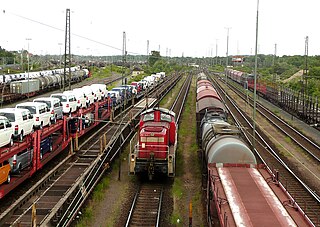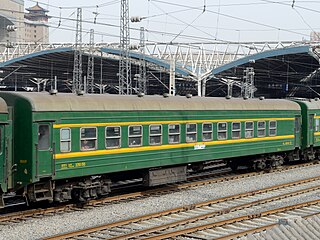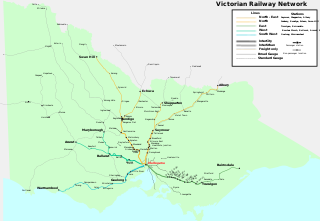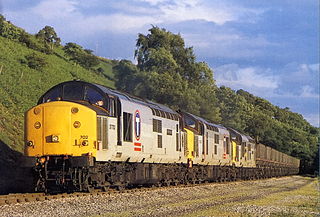
Rail transport is a means of transport using wheeled vehicles running in tracks, which usually consist of two parallel steel rails. Rail transport is one of the two primary means of land transport, next to road transport. It is used for about 8% of passenger and freight transport globally, thanks to its energy efficiency and potentially high speed.

A train is a series of connected vehicles that run along a railway track and transport people or freight. Trains are typically pulled or pushed by locomotives or railcars, though some are self-propelled, such as multiple units. Passengers and cargo are carried in railroad cars, also known as wagons. Trains are designed to a certain gauge, or distance between rails. Most trains operate on steel tracks with steel wheels, the low friction of which makes them more efficient than other forms of transport.

The term rolling stock in the rail transport industry refers to railway vehicles, including both powered and unpowered vehicles: for example, locomotives, freight and passenger cars, and non-revenue cars. Passenger vehicles can be un-powered, or self-propelled, single or multiple units. A connected series of railway vehicles is a train.

A railroad car, railcar, railway wagon, railway carriage, railway truck, railwagon, railcarriage or railtruck, also called a train car, train wagon, train carriage or train truck, is a vehicle used for the carrying of cargo or passengers on a rail transport network. Such cars, when coupled together and hauled by one or more locomotives, form a train. Alternatively, some passenger cars are self-propelled in which case they may be either single railcars or make up multiple units.

VR-Group Plc, commonly known as VR, is a government-owned railway company in Finland. VR's most important function is the operation of Finland's passenger rail services with 250 long-distance and 800 commuter rail services every day. With 7,500 employees and net sales of €1,251 million in 2017, VR is one of the most significant operators in the Finnish public transport market area.

Intermodal freight transport involves the transportation of freight in an intermodal container or vehicle, using multiple modes of transportation, without any handling of the freight itself when changing modes. The method reduces cargo handling, and so improves security, reduces damage and loss, and allows freight to be transported faster. Reduced costs over road trucking is the key benefit for inter-continental use. This may be offset by reduced timings for road transport over shorter distances.

DB Cargo UK, is a British rail freight company headquartered in Doncaster, England.
Rail transport operations are the day-to-day operations of a railway. A railway has two major components: the infrastructure and the rolling stock

Rail transport in the Australian state of Victoria is provided by a number of railway operators who operate over the government-owned railway lines. The network consists of 2,357 km of Victorian broad gauge lines, and 1,912 km of standard gauge freight and interstate lines; the latter increasing with gauge conversion of the former. Historically, a few experimental 762 mm gauge lines were built, along with various private logging, mining and industrial railways. The rail network radiates from the state capital, Melbourne, with main interstate links to Sydney and to Adelaide, as well as major lines running to regional centres, upgraded as part of the Regional Fast Rail project.

A rail yard, railway yard, railroad yard (US) or simply yard, is a series of tracks in a rail network for storing, sorting, or loading and unloading rail vehicles and locomotives. Yards have many tracks in parallel for keeping rolling stock or unused locomotives stored off the main line, so that they do not obstruct the flow of traffic. Cars or wagons are moved around by specially designed yard switcher locomotives (US) or shunter locomotives (UK), a type of locomotive. Cars or wagons in a yard may be sorted by numerous categories, including railway company, loaded or unloaded, destination, car type, or whether they need repairs. Yards are normally built where there is a need to store rail vehicles while they are not being loaded or unloaded, or are waiting to be assembled into trains. Large yards may have a tower to control operations.

Intermodal passenger transport, also called mixed-mode commuting, involves using two or more modes of transportation in a journey. Mixed-mode commuting is often used to combine the strengths of various transportation options. A major goal of modern intermodal passenger transport is to reduce dependence on the automobile as the major mode of ground transportation and increase use of public transport. To assist the traveller, various intermodal journey planners such as Rome2rio and Google Transit have been devised to help travellers plan and schedule their journey.

Rail freight transport is the use of railways and trains to transport cargo as opposed to human passengers.

Tinsley was a railway marshalling yard near Tinsley in Sheffield, England, used to separate railway wagons from incoming trains and add them to new trains. It was sited immediately west of the M1 motorway, about one mile north of the Catcliffe junction. It was opened in 1965, as a part of a major plan to rationalise all aspects of the rail services in the Sheffield area; it closed in stages from 1985, with the run-down of rail freight in Britain. It was also the site of Tinsley Traction Maintenance Depot (TMD), which was closed in 1998; at its peak, 200 locomotives were allocated to this depot.

A mixed train or mixed consist is a train that contains both passenger and freight cars or wagons. Although common in the early days of railways, by the 20th century they were largely confined to branch lines with little traffic. Typically, service was slower, because mixed trains usually involved the shunting (switching) of rolling stock at stops along the way. However, some earlier passenger expresses, which also hauled time-sensitive freight in covered goods wagons (boxcars), would now be termed mixed trains. Generally, toward the end of the mixed train era, shunting at intermediate stops had significantly diminished. Most railway passenger and freight services are now administered separately.

SBB Cargo is a subsidiary of Swiss Federal Railways (SBB) specialising in railfreight and is operated as the Freight division. Swiss Federal Railways is a former state-owned and -controlled company that was transformed in 1999 into a joint-stock company under special legislation following the first Swiss railway reform and divided up into three independent divisions: Passenger, Freight and Infrastructure. The headquarters of Swiss Federal Railways SBB Cargo AG, the Freight division's official designation, are in Olten. In 2013, SBB Cargo had 3,061 employees and achieved consolidated sales of CHF 953 million. In Switzerland, SBB Cargo is the market leader in rail freight, transporting over 175,000 tons of goods every day. This corresponds to the weight of 425 fully loaded jumbo jets.

Land transport is the transport or movement of people, animals or goods from one location to another location on land. This is in contrast with other main types of transport such as maritime transport and aviation. The two main forms of land transport can be considered to be rail transport and road transport.

Open wagons form a large group of railway goods wagons designed primarily for the transportation of bulk goods that are not moisture-retentive and can usually be tipped, dumped or shovelled. The International Union of Railways (UIC) distinguishes between ordinary wagons and special wagons (F/6). Open wagons often form a significant part of a railway company's goods wagon fleet; for example, forming just under 40% of the Deutsche Bahn's total goods wagon stock in Germany.

The railway network in Great Britain has been used to transport goods of various types and in varying volumes since the early 19th century. Network Rail, which owns and maintains the network, aims to increase the amount of goods carried by rail. In 2015–16 Britain's railways moved 17.8 billion net tonne kilometres, a 20% fall compared to 2014–15. Coal accounted for 13.1% of goods transport in Britain, down considerably from previous years. There are no goods transported by railway in Northern Ireland.
The Condor was an overnight fast freight train service operated by British Railways between London and Glasgow from 1959 until 1965 with all freight carried in containers. The name was derived from 'CONtainers DOoR-to-Door'.





















